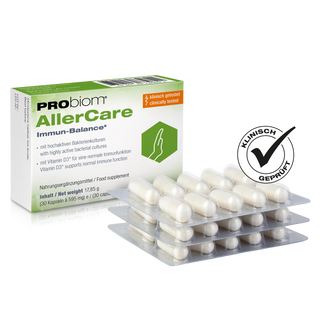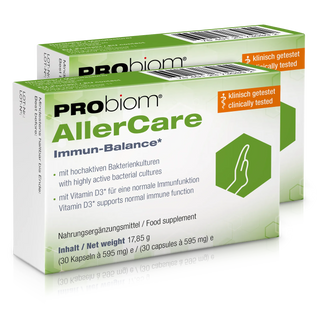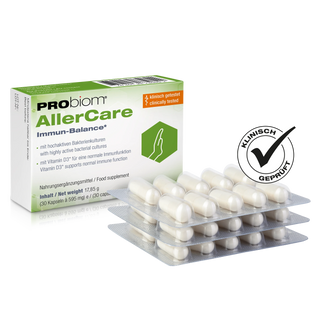Allergies are often considered a fate. Every year, millions of people suffer from hay fever, food intolerances, or skin reactions. But what if allergies aren't an unavoidable condition? What if you could systematically alleviate them—or even eliminate them permanently?
Modern microbiome research is providing promising approaches for precisely this. More and more studies are showing that the origin of many allergies lies in the gut. A disturbed balance of the intestinal flora—known as dysbiosis—can make the immune system hypersensitive. The good news: With targeted intestinal care, dietary changes, and probiotic strains, this balance can be restored.
In this article, you'll learn how to develop an effective allergy strategy in just a few weeks that addresses the root cause. It's holistic, scientifically sound, and suitable for everyday use.
Understanding Allergies: When the Immune System Goes Off Track
Allergies are an exaggerated reaction of the immune system to otherwise harmless substances. Whether pollen, house dust mites, pet dander, or food: the immune system perceives them as a threat and triggers an inflammatory response.
Typical symptoms:
-
Runny nose, itchy eyes, sneezing (e.g. with hay fever)
-
Skin rashes, neurodermatitis, eczema
-
Breathing difficulties, asthma
-
Digestive problems, flatulence, intolerances
But why is the immune system so hypersensitive? A key factor is the balance between immune defense and tolerance. And this balance is largely regulated by the gut microbiome .
The intestine: immune center and allergy control center
70 to 80% of the body's immune cells are located in the intestines. This is where the decisions are made as to which substances are classified as dangerous and combated – and which are tolerated. A healthy, diverse intestinal flora is crucial. It produces so-called short-chain fatty acids (SCFAs) such as butyrate, which have an anti-inflammatory effect and stabilize the intestinal mucosa.
However, allergy sufferers often show a disturbed microbiota:
-
Less diversity of beneficial bacteria
-
Too few regulatory T cells (Tregs) that prevent overreactions
-
Leaky gut lining that promotes immune reactions
This means that the path to allergy relief leads through a targeted restoration of intestinal health.
Week 1–2: Reduce allergens, relieve intestinal tract
The first step is to reduce irritants . Allergens must be avoided as much as possible so that the intestines and immune system can rest.
Important measures:
-
Install pollen filters in your home and car
-
Use air purifier (HEPA)
-
Temporarily low-histamine diet (less alcohol, mature cheese, tomatoes)
-
Gluten and lactose-free test phase
-
No sugar bombs or industrially processed products
At the same time, you begin to relieve intestinal congestion. Bitters, psyllium husks, and increased water intake help. The goal is to reduce inflammation and regenerate the mucous membranes.
Week 3–4: Build and stabilize the microbiome
Now comes the key step: targeted microbiome reconstruction .
Important:
-
High-fiber foods (linseed, oats, artichokes, chicory)
-
Prebiotics such as inulin or resistant starch
-
Fermented foods such as sauerkraut, kefir, kimchi, miso
-
Daily exercise and stress reduction promote the environment
And: Use probiotics in a targeted manner. The following strains are particularly interesting for allergy sufferers:
-
Lactobacillus rhamnosus GG : Reduces atopic dermatitis and modulates the immune system
-
Bifidobacterium longum BB536 : Antihistamine effect, regulates TH1/TH2 balance
-
Lactobacillus casei Shirota : Proven anti-allergic for pollen allergies
-
Lactobacillus paracasei LP-33 : Studies show significant effects on hay fever, house dust and pet hair allergies as well as atopic dermatitis
-
Lactobacillus paracasei GMNL-133 : Excellent complement to LP-33, enhances immune modulation, also effective for inhalant allergies
It should be taken for at least 8 weeks. It's ideal in combination with prebiotics for a synbiotic effect.
Weeks 5–8: Build tolerance, train the immune system
Now it's all about restoring oral tolerance —the immune system's ability to avoid overreacting to harmless substances. The combination of a stable microbiome and gentle allergen exposure leads to a significant reduction in reactions.
What you can do now:
-
Reintroduce small amounts of previously intolerant foods
-
Use pollen season for controlled contact (if necessary under medical supervision)
-
Use anti-inflammatory phytochemicals (e.g. quercetin, black cumin oil)
-
Maintain a gut-friendly diet
It will slowly become apparent whether your system has stabilized. Many people report noticeable improvements during this phase—less itching, better sleep, more energy.
Table: Probiotic strains with antiallergic potential
| tribe | Effect according to studies | Form of intake |
|---|---|---|
| L. rhamnosus GG | Treg promotion, reduction of atopic dermatitis | Capsule, powder |
| B. longum BB536 | TH2 suppression, histamine lowering | Yogurt, supplement |
| L. casei Shirota | Inhibits allergic reactions to pollen | Fermented drink |
| L. paracasei LP-33 | Relieves nasal symptoms of hay fever, pet hair, dust, neurodermatitis | capsule |
| L. paracasei GMNL-133 | Immunomodulating, LP-33 supports inhalant allergies | capsule |
| B. breve M-16V | Positive in children with atopic dermatitis | drops, powder |
Conclusion: Allergy-free is possible
The path to an allergy-free life doesn't involve short-term antihistamines, but rather a long-term rebuilding of your immune system. And that starts in the gut. With a combination of targeted nutrition, intestinal relief, pre- and probiotic support, and immune training, you can reset your system within a few weeks.
Not every allergy disappears immediately, but many symptoms can be drastically reduced. Those who stick with it can experience a new freedom in just a few months: breathing more clearly, eating more freely, and living a more relaxed life.















